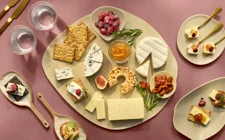
STILTON (PDO)
What is Stilton?
Stilton has a beautiful interior, streaked like marble, and the texture is crumbly and almost soft - relatively delicate compared to its stout and bold flavours. Intense and rich, the taste is complex, opening with creamy and nutty specks, followed by a salty finish that sticks to your palate.
Retaining the ideals of quality throughout all aspects of production, cows grazing on pastures in the midlands of England provide the fresh milk needed to make original Stilton. These wide plains among the moors in the heart of England offer lush forage for the cattle, which is clearly reflected in the final product.
Pastas, risottos and desserts all benefit from the addition of Stilton, and salads fair especially well when mixed with light crumbles. Honey, walnuts and sliced apples complement the nuances of the cheese perfectly on a cheeseboard.
How Stilton is made
The art of making Stilton has remained very much the same as when it was first produced. Only made in certain parts of England, production relies on careful selection and maturing.
Fresh pasteurised milk is poured into large vats at dawn every day, followed by a blend of cultures and rennet. A special yeast that allows for the mould to develop and grow at a quickened rate is also included in the mixture. Once the milk has curdled, it is cut, separated and left for the whey to strain off. Milled and salted, the curd is then transferred into moulds. Workers then place the moulds on shelves and turn them daily, making sure never to compress the curd, as this would prevent the fostering of the flaky texture. Almost a week later, the curd is smoothed by hand and set to age for around 5 weeks. At this point, the cheese is pierced with steel needles, allowing the blue veins to breathe and grow. After 9 weeks, the cheese is ready to be sent out to shops.
Curious about the world of cheese? Here's everything you need to know about how to store, serve and cut cheese!

Discover our cheeses
A world of surprising and indulgent sensations







